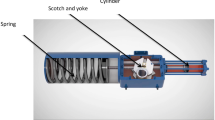Abstract
The study determines the feasibility of a new actuation system that couples a fluidic artificial muscle designed by Festo [1] with a metal hydride hydrogen compressor to create a compact, lightweight, noiseless system capable of high forces and smooth actuation. An initial model for the complete system is developed. The analysis is restricted in some aspects concerning the complexity of the hydriding/dehydriding chemical process of the system and the three-dimensional geometry of the reactor, but it provides a useful comparison to other actuation devices and clearly reveals the parameters necessary for optimization of the actuation system in future work. The system shows comparable work output and has the benefits of biological muscle-like properties [2] for use in robotic systems. When compared to other previously developed metal hydride actuation systems the potential for increasing the reaction kinetics and improving the overall power output of the system is revealed. A comparison of the system to common actuation devices, including a biological muscle, shows similar stress and strain relations, but a lower power and frequency range due to the slow actuation time. Improving the reaction kinetics of the system will be the first approach to enhancing the system, along with optimization of the mass and type of metal hydride used in the reactor to produce a full actuation stoke of the fluidic muscle while minimizing system weight.
Similar content being viewed by others
References
Festo, www.festo.com
G.K. Klute and J.M Czerniecki, B. Hannaford Int. J. Robotics Research. 21 (4), 295 (2002).
C. Chou and B Hannaford, Report No. G93268R, 1996.
F. Daerden, Ph.D Thesis, Vrije Universiteit Brussel, 1999.
M.R. Gopal and S.S. Murthy, Int.J.Hydrogen Energy. 20, 911 (1995).
M.R. Gopal and S.S. Murthy, Int. J.Hydrogen Energy. 17(10), 795 (1992).
F.P. Incropera and D.P Dewitt, Introduction to Heat Transfer. (John Wiley & Sons, Inc. New York, 2002).
M. Lee, Master Thesis, University of Nevada, Reno, 2007.
K.J. Kim, Active Materials and Processing Laboratory (metal hydride property information) University of Nevada, Reno.
S. Shimizu and S. Ino, M. Sato, T. Odagawa, T. Izumi, M. Takahashi, T. Ifukube Report No. N12 W6, Hokkaido University, 1993.
W. Yuichi and M. Muro, T. Kabutomori, H. Takeda, S. Shimizu, S. Ino, T. Ifukube IEEE 5, 148 (1997).
C. Kiyoung and K.J. Kim, D. Kim, C. Manford, S. Heo, M. J. Shahinpoor Intelligent Material Systems and Structures. 17, 563 (2006).
<http://www.festo.com/cat/en-us_us/data/doc_enus/PDF/US/DMSP-MAS_ENUS.PDF> (fluidic muscle specifications) 2008.
Author information
Authors and Affiliations
Rights and permissions
About this article
Cite this article
Vanderhoff, A., Kwang, J.K. Metal Hydride Fluidic Artificial Muscle Actuation System. MRS Online Proceedings Library 1129, 501 (2008). https://doi.org/10.1557/PROC-1129-V05-01
Received:
Accepted:
Published:
DOI: https://doi.org/10.1557/PROC-1129-V05-01




